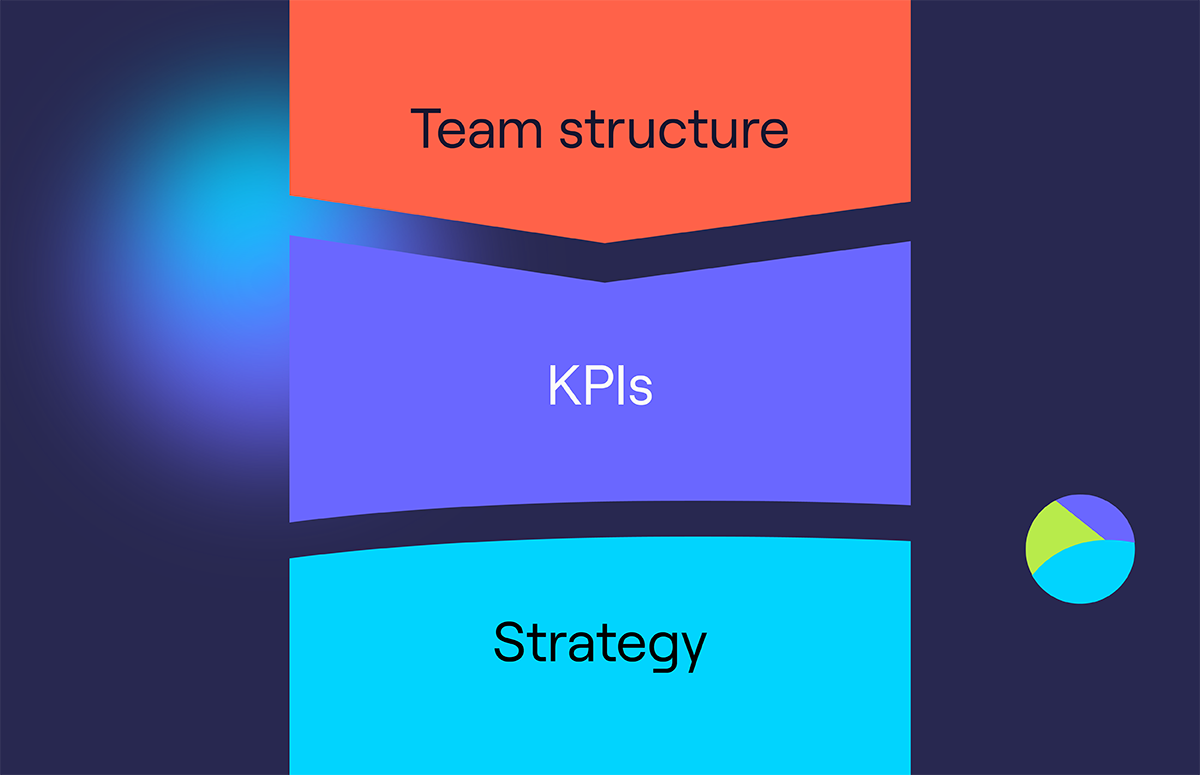How the RevOps Flywheel Reduces Buying Friction
RevOps flywheel menu:
Sales and marketing teams have been using the funnel model for decades. In 2025 and beyond, it’s more than a little out of date.
Don’t get me wrong; it’s helped me understand how buyers move through the B2B sales process.
The problem is it’s just not sophisticated enough.
I mean, the sales funnel was designed back when marketing just generated leads and handed them off to sales to close. Back before customer success even existed.
It’s time to level up and switch to a model that aligns more with what modern revenue teams believe in.
The RevOps flywheel.
Now, I’m deep-diving into the concept and thinking behind the revenue operations flywheel. You’ll learn why it’s a better model than the sales funnel and how to implement it practically.
Read on! 👇
What is the RevOps flywheel?
This one seems like a pretty simple question, but it has a relatively complex answer.
The short and fast way is to look at it like this:
The RevOps flywheel is a model designed to represent how the continuous and interconnected processes that RevOps run contribute to revenue growth.
But to really understand the RevOps flywheel, we have to take a step back, right back to 2018, when HubSpot first introduced the idea of a flywheel to the world of sales and marketing.
👉 Cognism is helping RevOps teams like yours! Find out more about how our quality data will fuel your pipeline.
Introducing the flywheel concept
Up until that point, most marketing and sales teams used the funnel to conceptualise how non-customers became customers.
It looked like this; I’m sure you’ve seen it before.

The idea was that you start with a large group of prospective customers. As you move through the various funnel stages (such as qualification, evaluation, and intent), prospects drop out of it.
The group of potential buyers gets smaller and smaller as you get closer to the end of the sales cycle; it tapers down, just like a funnel.
While the funnel was (and still is) valuable as a model for customer acquisition, its fatal flaw is that it’s too focused on acquisition as the growth driver.
Every revenue leader today knows that acquisition isn’t the only lever for revenue generation. Retention, expansion, and referrals are big revenue drivers, too.
So HubSpot took the broad funnel stages and wrapped them around the idea of growth, not acquisition.

At first glance, the revenue operations flywheel is just the same broad stages you see in the funnel model, just presented in a different format.
But the flywheel is a much more apt metaphor for how modern revenue teams operate.
Customer advocacy
First, it puts a huge emphasis on the impact of happy customers on revenue growth. The funnel model doesn’t consider customers once they’ve fallen out the other side.
But the flywheel model recognises the fact that satisfied customers:
- Come back to buy again (or renew).
- Buy more (through cross-sells and upsells).
- Create more prospects (via word of mouth).
Energy source
Secondly, the source of energy is vastly different.
In the funnel metaphor, gravity is the energy source. Leads “fall through” the funnel, and the energy disappears after conversion.
In the flywheel, the energy source is momentum-based. There’s this idea of alignment between the three revenue teams driving the flywheel, which self-accelerates as it gains momentum, especially as exceptional customer engagements are added.
Practical applications of the two models
Finally, the flywheel model has a much more practical application.
With the funnel approach, all you can really do is keep plugging more prospects into the top. It becomes a volume game.
With the flywheel model, you’ve got these two ideas of force and friction.

Anything you and your team can do to make the flywheel spin faster from the centre is called force, and anything that slows down the flywheel is friction.
Adding force and reducing friction generate growth.
For example:
Optimising your marketing campaigns can add force, as you become better at attracting and engaging new prospective customers.
On the other hand, streamlining the renewal process with automated credit card retry processes can reduce friction and lower churn.
Putting RevOps at the centre of the flywheel
So, where does revenue operations enter the picture?
By putting RevOps at the centre of the flywheel, we can better conceptualise how our actions (such as optimising processes) impact our approach to revenue generation.

At the centre of the RevOps flywheel, we have the three revenue teams:
- Marketing
- Sales
- Customer Success
The better these three teams are aligned (i.e., the less friction between them and the more force they can generate), the faster we can spin the flywheel.
On the next layer, we have the four key tenets of RevOps: people, processes, data, and technology.
Again, the more we can reduce friction and increase force (e.g. by improving integrations across our revenue tech stack or reducing wasted time searching for correct data points), the faster the flywheel can spin.
At the outer edge, we have those same three funnel stages: attract, engage, and delight. These represent the broad stages potential customers pass through as they make buying decisions and indicate the impact of positive customer experiences (delight) on your growth opportunities.
How does the RevOps flywheel work?
The revenue operations flywheel works by creating momentum through continuous alignment and optimisation of the three core revenue teams (marketing, sales, and CS). The foundational pillars of people, processes, data, and technology support them.
As friction is reduced and force is applied across these components, the flywheel spins faster, attracting, engaging, and delighting customers.
Here’s an example to illustrate how we can apply the RevOps flywheel model to drive growth.
Alignment is the big driver here. We’ll align on things like our ideal customer profile (ICP), metrics to track across the entire organisation, and how we’ll share data across teams and connect software systems.
Then, we’ll start optimising across our four foundational pillars.
For example:
- People. We’ll conduct cross-functional training to ensure everyone understands how their roles impact the broader revenue cycle, such as teaching sales how to set customer success up for retention.
- Processes. We’ll implement standardised handoff processes and create a lead-scoring program that incorporates both sales and marketing data.
- Data. We’ll introduce a regular data cleansing protocol and an automatic enrichment process to provide revenue teams with timely, accurate data.
- Technology. We’ll tear down silos by uniting all revenue teams in a single CRM, which will act as the central hub to which all other software tools connect.
These improvements help us drive success across all three stages of the customer journey: attract, engage, and delight.
For example:
Cognism’s data enrichment initiatives improve our customers’ ability to target high-intent buyers, adding force to the attraction stage. Our integrated tech stack removes friction at the engagement stage by allowing sales and marketing to collaborate more effectively and influence deals.
The cross-functional training we invest in allows CS to perform better at the delight stage, removing friction from customer onboarding and adding force to account expansion efforts. Both of these contribute directly to revenue growth.
The real-world impact of the RevOps flywheel
The RevOps flywheel is a model for understanding how our actions influence revenue growth. It isn’t a playbook or set of steps we can follow.
But that doesn’t mean it doesn’t have a real-world impact.
How does the RevOps flywheel align sales, marketing, and customer success?
The RevOps flywheel aligns the three revenue teams by:
- Emphasising shared goals such as revenue growth, pipeline velocity, and customer satisfaction.
- Creating unified processes and connecting tools to reduce internal friction and enhance collaboration.
- Helping team members understand the impact of their role on business growth.
How does the RevOps flywheel improve customer retention and growth?
Unlike the traditional funnel model, the RevOps flywheel doesn’t just focus on new customer acquisition.
It recognises that actions across the entire customer lifecycle, from initial interactions to post-sale support, impact brand perception, customer satisfaction, and retention.
Retention is a key revenue driver in and of itself, but happy customers are also more likely to promote the company and refer new buyers, which is where the flywheel loops back onto itself.
Practically speaking, the RevOps flywheel can help by:
- Reducing churn through streamlined onboarding processes.
- Improving communication between sales and customer success to drive upsell and cross-sell opportunities.
- Equipping the team with the right data to help them connect with ideal buyers, those who have a strong use case for the product and are less likely to churn.
How does the RevOps flywheel impact the customer experience?
The RevOps flywheel impacts the customer experience both directly and indirectly.
Direct impacts include reduced buying friction, a more cohesive buying process, and improved satisfaction and engagement from the success team.
The indirect impact comes from internal alignment. By eliminating gaps between teams, improving collaboration and communication, and breaking down data silos, RevOps leaders generate a more intuitive and seamless buying experience.
How can companies implement the RevOps flywheel effectively?
Let’s walk through some of the key steps involved in effectively integrating the RevOps flywheel model.
1. Embrace the flywheel model
Step one is about getting everyone on the same page.
It involves ensuring that every person across marketing, sales, and CS understands the core philosophy.
Training sessions will play an important role here. You’ll conduct workshops to introduce the flywheel, explain how it benefits the organisation, and how you’ll use it in practice.
Once the principal idea is understood and the revenue team is on board, you’ll start looking at success measurements.
You’ll want to move away from RevOps metrics that only apply to a single team (MQLs, for instance) and define shared goals that contribute to overall organisational growth, like revenue or customer lifetime value.
2. Leverage tools that support the RevOps flywheel model
Next, turn your attention to your tech stack.
The right RevOps tools can play a crucial role in reducing friction from and adding force to the flywheel.
Start by moving to a single CRM to use across the entire organisation. This will act as the centre of your tech stack, to which all marketing, sales, and success tools are interconnected.
Then, grow your capabilities by adding:
- Communication and collaboration tools.
- Data management and enrichment tools.
- Marketing automation and sales engagement.
- Revenue intelligence solutions to improve visibility.
- Account-based marketing tools to deliver personalised campaigns.
- Internal enablement and learning platforms.
- Customer feedback and voice of customer solutions.
3. Use data to optimise the flywheel
High-quality data is a major force multiplier for the RevOps flywheel.
Here are a few best practices to implement:
- Set up a data enrichment protocol so that when new leads enter the CRM they’re automatically enriched with prospect and company data.
- Use behavioural data (such as who is on your website) to inform multithreaded outreach campaigns.
- Set up real-time dashboards to monitor lead quality, deal velocity, and customer churn.
- Regularly analyse your current customers’ behavioural and demographic data; this will help you refine your targeting and messaging strategies.
- Leverage AI-powered tools and predictive analytics to forecast churn risks or identify upsell opportunities.
4. Track key metrics
What metrics do you need to track with the RevOps flywheel model?
Instead of breaking metrics down by team (which leads to siloes and conflicting goals), look at measuring success at different stages of the customer lifecycle.
For example:
- Attract stage: Lead quality, cost per lead (CPL), and marketing-sourced revenue.
- Engage stage: Lead-to-opportunity conversion rate, sales cycle length, and deal win rate.
- Delight stage: Net Promoter Score (NPS), churn rate, and customer expansion revenue.
Speeding up the RevOps flywheel
As a model for growth, the RevOps flywheel is a much better concept than the traditional funnel.
It much more closely represents how modern teams put customer satisfaction and success at the centre of their business strategy. And it requires us to think about force creators and friction reducers as success drivers.
To get your own RevOps flywheel spinning at full velocity, empower your revenue teams with timely, up-to-date, accurate B2B data.
Cognism is the perfect fuel for your revenue engine. Our AI-powered Sales Companion will help you to:
- Increase sales productivity: Connect with more decision-makers, close deals faster, and identify pivotal moments, such as funding announcements or key hires.
- Improve lead generation: Generate high-quality leads that convert.
- Reduce time waste: Eliminate manual research and data entry with fresh, quality signal data and tailored insights delivered daily.
- Ensure better compliance: Work with a global database that complies with the latest international privacy laws.
- Achieve higher ROI: Maximise marketing and sales efforts with accurate data.
To see the Cognism platform in action, click 👇 for a demo.

/Lead%20routing%20tools/lead-routing-tools-resource-card.webp)

